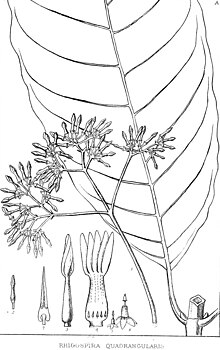Rhigospira is a genus of flowering plants in the family Apocynaceae, first described as a genus in 1878 by John Miers.[2] The species, Rhigospira quadrangularis was first described as Ambelania quadrangularis by Johannes Müller Argoviensis in 1860[3] but was transferred to the genus, Rhigospira, in 1878 by John Miers.[4] The genus contains only one known species, Rhigospira quadrangularis, native to northwestern South America (Colombia, Venezuela, Peru, NW Brazil).[5][6]
| Rhigospira | |
|---|---|

| |
| A. Rhigospira quadrangularis, portion of a plant. Fig. 1, the inflorescence. Fig. 2, a flower: both natural size. Fig. 3, the corolla in bud, showing the pyramidal form of the erect segments in aestivation. Fig. 4, the same cut open when expanded, showing their simple sinistrorse convolution and the nearly basal position of the stamens: both magnified. Fig. 5, the calyx, disk, very short style, clavuncle, and stigmata, natural size. Fig.6, the same, magnified. Fig. 7, a stamen, much magnified.[1] | |
| Scientific classification | |
| Kingdom: | Plantae |
| Clade: | Tracheophytes |
| Clade: | Angiosperms |
| Clade: | Eudicots |
| Clade: | Asterids |
| Order: | Gentianales |
| Family: | Apocynaceae |
| Subfamily: | Rauvolfioideae |
| Tribe: | Tabernaemontaneae |
| Subtribe: | Ambelaniinae |
| Genus: | Rhigospira Miers |
| Species: | R. quadrangularis
|
| Binomial name | |
| Rhigospira quadrangularis | |
| Synonyms[2] | |
| |
- formerly placed in the genus[5]
- Rhigospira paucifolia (Müll.Arg.) Miers = Macoubea guianensis Aubl.
- Rhigospira reticulata (A.DC.) Miers = Macoubea guianensis Aubl.
- Rhigospira sinuosa Miers = Macoubea guianensis Aubl.
- Rhigospira sprucei (Müll.Arg.) Miers = Macoubea sprucei (Müll.Arg.) Markgr.
- Rhigospira ternstroemiacea (Müll.Arg.) Miers = Neocouma ternstroemiacea (Müll.Arg.) Pierre
- Rhigospira venulosa Miers = Spongiosperma macrophyllum (Müll.Arg.) Zarucchi
References
edit- ^ Miers, J. (1878). On the Apocynaceae of South America, with some preliminary remarks on the whole family. p. 269.
- ^ a b "Rhigospira quadrangularis (Müll.Arg.) Miers | Plants of the World Online | Kew Science". Plants of the World Online. Retrieved 2020-05-30.
- ^ Müller Argoviensis, J. (1860). C.F.P. von Martius (ed.). "Ambelanaia quadrangularis". Flora Brasiliensis. 6 (1): 18.
- ^ Miers, J. (1878). On the Apocynaceae of South America, with some preliminary remarks on the whole family. p. 68.
- ^ a b Kew World Checklist of Selected Plant Families
- ^ Hokche, O., Berry, P.E. & Huber, O. (eds.) (2008). Nuevo Catálogo de la Flora Vascular de Venezuela: 1-859. Fundación Instituto Botánico de Venezuela.